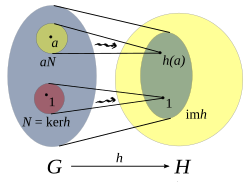
Back تشاكل الزمر Arabic Qrupların homomorfizmi Azerbaijani Homomorfisme de grups Catalan Gruppehomomorfi Danish Gruppenhomomorphismus German Grupa homomorfio Esperanto Homomorfismo de grupos Spanish همریختی گروهی Persian Ryhmähomomorfismi Finnish Morphisme de groupes French

| Algebraic structure → Group theory Group theory |
|---|
 |
In mathematics, given two groups, (G,∗) and (H, ·), a group homomorphism from (G,∗) to (H, ·) is a function h : G → H such that for all u and v in G it holds that
where the group operation on the left side of the equation is that of G and on the right side that of H.
From this property, one can deduce that h maps the identity element eG of G to the identity element eH of H,
and it also maps inverses to inverses in the sense that
Hence one can say that h "is compatible with the group structure".
In areas of mathematics where one considers groups endowed with additional structure, a homomorphism sometimes means a map which respects not only the group structure (as above) but also the extra structure. For example, a homomorphism of topological groups is often required to be continuous.
© MMXXIII Rich X Search. We shall prevail. All rights reserved. Rich X Search



